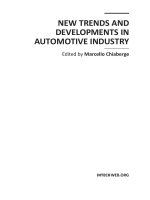New Trends and Developments in Automotive Industry Part 11 ppt
Bạn đang xem bản rút gọn của tài liệu. Xem và tải ngay bản đầy đủ của tài liệu tại đây (5.59 MB, 35 trang )
Development of a New 3D Nonwoven for Automotive Trim Applications
339
0,00
20,00
40,00
60,00
80,00
100,00
Compressibility (%)
Dissipated energy (N.m/m2)Resilience (%)
m1
m2
NT1
NT2
NT3
NT4
Fig. 24. Compressional characteristics of the tested monolayer samples (KES-FB3)
0,00
20,00
40,00
60,00
80,00
100,00
Compressibility (%)
Dissipated energy (N.m/m2)Resilience (%)
Cm
L1_NT1
L1_NT2
L1_NT3
L1_NT4
L2_NT1
L2_NT2
L2_NT3
L2_NT4
Fig. 25. Compressional characteristics of the tested multilayer samples (KES-FB3)
Regarding the compression test on five cycles, it has also been observed that the
VERTILAP
®
products are more resilient and dissipate more energy than the tested PU
foams. These observations have been done in both cases of the monolayer and laminated
products (Fig. 26 - 29). The analysis of the raw results has shown differences between the
behaviour of the 3D nonwoven and the PU foam. It has been observed an important
reorganisation of the fibrous structure in the case of the 3D nonwoven while the cellular
structure of the PU foam remained more constant. This reorganisation displays different
individual behaviours of the filaments inside the pleated structure.
The results of this campaign have shown interesting properties of the VERTILAP
®
products
in terms of comfort and mechanical behaviour compared with the tested PU foams. At this
step, the main drawback of this new 3D nonwoven is its weight and its poor reproducibility.
In fact, the obtained results have shown high dispersion values in the case of the
VERTILAP
®
products. A second campaign has been carried out in order to reach the goal of
the weight reduction of the VERTILAP
®
products.
New Trends and Developments in Automotive Industry
340
0,00
10,00
20,00
30,00
40,00
Cycle 1 Cycle 2 Cycle 3 Cycle 4 Cycle 5
Maximal stress at 50% (kPa)
NT1 NT2 NT3
NT4 m1 m2
Fig. 26. Maximal stress at 50% deformation of initial thickness of the tested monolayer
samples
0
5
10
15
20
Cycle 1Cycle 2Cycle 3Cycle 4Cycle 5
Dissipated energy (Joules)
NT1 NT2 NT3
NT4 m1 m2
Fig. 27. Dissipated energy of the tested monolayer samples
Development of a New 3D Nonwoven for Automotive Trim Applications
341
0,00
50,00
100,00
150,00
200,00
Cycle 1Cycle 2Cycle 3Cycle 4Cycle 5
Maximal stress at 50% (kPa)
L1_NT1 L1_NT2 L1_NT3
L1_NT4 L2_NT1 L2_NT2
L2_NT3 L2_NT4 Cm
Fig. 28. Maximal stress at 50% deformation of initial thickness of the tested multilayer samples
0
20
40
60
80
100
Cycle 1 Cycle 2 Cycle 3 Cycle 4 Cycle 5
Dissipated energy (Joules)
L1_NT1 L1_NT2 L1_NT3
L1_NT4 L2_NT1 L2_NT2
L2_NT3 L2_NT4 Cm
Fig. 29. Dissipated energy of the tested multilayer samples
New Trends and Developments in Automotive Industry
342
4.3.2 Campaign B
In this experiment, the previous production procedure has been applied to manufacture the
VERTILAP
®
products of this campaign but the technique to divide the initial tow of 90 ktex
has been improved by spreading the tow between two beams in order to apply a minimal
tension necessary for the filaments separation. Tows presenting a count from 7 ktex to
10 ktex have been pleated. During the manufacturing process, the speed before the
verticalisation zone has been varied. The obtained single 3D nonwovens have been
laminated at a speed of 5 m/min at 120°C. The hot melt adhesive was a 20 g/m²
co-polyester web with a melting temperature of 60/75°C. It is also important to note an
increase of 60% of the laminating speed compared to the previous samples (NT1, NT2, NT3
and NT4). This result enables to validate the products/process procedure.
The results of characterisation have shown a decrease of the weight of the 3D nonwovens
compared to the previous samples. Indeed, the single 3D nonwovens present a mass per
unit area of 164 g/m² while the mass per unit area of the laminated ones is 484 g/m².
Structure’s irregularity has been observed on the manufactured 3D nonwovens. This
irregularity is mainly due to the irregularity in the tow. In fact, finer the tow, the more
irregular the structure is as expressed in the Martindale’s law (Martindale, 1945).
Regarding the physical characteristics (Fig. 30) in the case of the monolayer products, the
objective of lightness has been reached and the 3D nonwoven, NT5, is also more comfortable
in term of air permeability compared with the tested foams (m1, m2). NT5 also presents a
better thermal insulation property compared with m1 sample. In the case of the multilayer
products, the foam (Cm) present better physical characteristics compared with the
laminated 3D nonwoven (L3 sample).
0,00
20,00
40,00
60,00
80,00
100,00
Weight (g/m²), Scale1/10
Air permeability (cm3/cm2/s)
K (W/m.K), Scale 1x1000
Thickness (mm), Scale 1x10
m1
m2
NT5
Cm
L3
Fig. 30. Physical characteristics of the tested samples
Regarding the compression properties on one cycle (Fig. 31), a balance has been observed
between the resilience and the dissipated energy in the case of single and laminated 3D
nonwovens. This result shows that this new product presents, simultaneously, good
resilient property and suitable comfort (soft touch). Except the problem of structure’s
irregularity, the characteristics of the obtained 3D nonwovens have been significantly
improved. In both cases of monolayer and multilayer products, it has been observed that the
Development of a New 3D Nonwoven for Automotive Trim Applications
343
VERTILAP
®
products and the foam present globally the same resilient property but the
foams dissipated less energy. It can be said that, the VERTILAP
®
products present better
characteristic in term of comfort (soft touch).
0,00
20,00
40,00
60,00
80,00
100,00
Compressibility (%)
Dissipated energy (N.m/m2)Resilience (%)
m1
m2
NT5
Cm
L3
Fig. 31. Compressional characteristics of the tested samples
The compression curves of the tested samples are presented on Fig. 32.
0,00
0,50
1,00
1,50
2,00
2,50
3,00
0,00 1,00 2,00 3,00 4,00 5,00 6,00 7,00 8,00
Thickness (mm)
Pressure (kPa)
L3
NT5
Cm
m1
m2
Fig. 32. Compression curves on one cycle (KES-FB3) of the tested samples
In addition to the previous characterization, the study of the tailorability of these new
products has been carried out. The tailorability of the VERTILAP
®
3D nonwoven has been
positively validated through the execution of upholsteries for a headrest and door panels
(Fig. 33). These automotive prototypes have been visually and tactically assessed thanks to
sensory panelists (Philippe et al., 2004) and textile industrialists.
New Trends and Developments in Automotive Industry
344
Fig. 33. Automotive prototypes with VERTILAP
®
products
At the end of this campaign, the initial question of PU foam replacement has found a
positive answer. Indeed, the development of the experimental prototype has allowed
improving the quality of the final product especially in terms of weight and comfort in the
case of the monolayer products. Nevertheless, the feeding material presents the problem of
the structure’s irregularity. The final results show that the developed products/process
procedure has been successfully implemented and has permitted to improve the process
and the expected products.
5. Conclusions and outlook
One original point of the VERTILAP project is the cluster that has been built for it (scientists,
textile companies and competitiveness clusters). This cluster has made possible the
development of an innovative 3D nonwoven. This work has contributed to increase know-
how on the VERTILAP
®
process and knowledge on the obtained pleated 3D nonwoven in
terms of methods and tools of characterisations. This study has shown that the new 3D
nonwoven present good qualities, in terms of compressional behaviour and comfort (soft
touch, air permeability and thermal insulation), compared to the current automotive PU
foam. The realisation of the automotive parts (headrest and door panel) with this new
product has shown that the VERTILAP
®
products present good suitable taylorability
properties. At this step of the work, the question initially asked “can the PU foam be
replaced by the VERTILAP
®
3D nonwoven?” has found a positive answer and the
recyclability problem has been solved. It can be said that the VERTILAP
®
3D nonwoven
could be a good candidate to replace certain PU foam in automotive trim applications.
Moreover, the obtained results during this work have generated data that will be used to
develop a new VERTILAP
®
prototype of 1m width. This new prototype will be
manufactured by the new subsidiary company NSC Environnement of the NSC Group. This
new machine will allow conducting industrial testing campaign at high speeds of
production. Different feeding materials such as nonwoven web or carded web will be used
in order to obtain a good homogeneity of the product. The obtained 3D nonwovens thanks
to this new prototype will be characterised through more investigations. In fact,
characteristics such as the behaviour modelling, the acoustic insulation, the comfort through
sensory analysis and the taylorability could be realised.
The forthcoming of the VERTILAP project has been initiated in order to extend the
development of the new 3D nonwoven beyond automotive applications. This second phase
has been labelled, in 2009, by the French competitiveness “Fibres Innovative Cluster”. New
Development of a New 3D Nonwoven for Automotive Trim Applications
345
industrial partners (Freudenberg Politex, Paul Hartmann, DIROY, Jacob Holm Industries,
Albany International, Steelcase) have joined the project VERTILAP for this industrial phase.
6. Acknowledgment
This work has been done thanks to the financial support of Alsace Region, the Département
du Haut-Rhin and OSEO.
7. References
Berthier, J-C. (2009), Polyuréthanes PUR, Techniques de l’ingénieur, (janvier 2009), pp 1-20,
AM3425v2
BS 5'636 (1990), Determination of air permeability of textile fabric
Caudron, J.C. (2003), Etude du marché du polyuréthane et Etat de l’art de ses techniques de
recyclage, Rapport de l’ADEME (Agence de l’Environnement et de la Maîtrise de
l’Energie), (27 juin 2003)
DGE (2005), Etude sur les Textiles Techniques, Rapport de la Direction Générale des Entreprises
(DGE), France, (Juin 2005)
Drean, E. (2006), Contribution to the development of piezoelectric sensors for the mechanical
characterisation of textile fabrics, PhD Thesis, University of Haute Alsace, Mulhouse,
France
Dumas, J-L.; Schaffhauser, J-B. (2007). Patent N° WO2007125248, N.Schlumberger Company
EU Directive (2000), Directive 2000/53/CE of the European parliament and council of 18
th
September 2000 related to the End Life Vehicle, Official journal of the European
Communities, 2000
Faucon, C. (1995), Les exigences fonctionnelles des matériaux de garnissage dans
l’automobile, Actes du 61
ème
congrès de l’ACIT, pp 65-80, Lille, juin 1995, France
Fung, W., Hardcastle, M. (2001), Product engineering – Interior trim, Textiles in automotive
engineering, In: Textiles in automotive engineering, The Textile Institute, pp 194-211,
Woodhead Publishing Limited, ISBN 1 85573 493 1, Cambridge, England
Hopkins, J. (1995), A comparative analysis of laminating automotive textiles to foam, Journal
of coated fabrics, (January 1995), pp 250-267
ISO 1798 : 1983, Flexible cellular polymeric materials – Determination of tensile strength and
elongation at break, Ed.2
ISO 3386/1: 1986, Polymeric materials, cellular flexible – Determination of stress-strain
characteristics in compression – Part 1: Low density materials
ISO 3795: 1989, Road vehicles, and tractors and machinery for agriculture and forestry –
Determination of burning behaviour of interior materials
ISO 1856: 2000, Flexible cellular polymeric materials – Determination of compression set,
Ed. 3
ITF (1990), Les matériaux textiles utilisés dans les habitacles des véhicules de transport,
Extraits du stage des 23 et 24 octobre 1990, 12, Institut Textile de France, Lyon, France,
(octobre 1990)
Kamprath, A. E. (2004), End-of-Life vehicles Recovery and Recycling polyurethanes Car
Components Options Analysis, Recticel,
New Trends and Developments in Automotive Industry
346
Karl Mayer Group (2007), Technical textiles, The Karl Mayer guide to Technical Textiles,
consulted in
January 2007
Kawabata, S. (1980), The standardization and analysis of hand evaluation, (Ed. 2), The
Textile Machinery Society of Japan, Osaka
Martindale, J. G. (1945), A new method of measuring the irregularity of yarns with some
observations on the origin of irregularities in worsted slivers and yarns, Journal of
the Textile Institute, Vol.36, (March 1945), T38-T47
Meyer Company, Flatbed laminating system, Maschinen Fabrik Herbert Meyer GmbH,
www.meyer-machines.com, consulted in November 2007
Némoz, G. (1999), Les textiles (presque) partout dans l’automobile, TUT, N° 32., (2
nd
quarter
1999) pp16-18
Njeugna, N. (2009), Contribution to the development and the industrialisation of a 3D nonwoven
system, PhD Thesis No. 2009/23, University of Haute Alsace, Mulhouse, France
Njeugna, N., Adolphe, D. C., Schacher, L., Schaffhauser, J-B., Strehle, P. (2008), Modification
of compressional testing procedures for 3D nonwoven system for automotive
interior applications, Proceedings of the 4
th
International Textile Clothing & Design
Conference, pp 859-863, ISBN 978-953-7105-26-6, Dubrovnik, October 2008
NSC (2007), The TT12 crush cutting Converter, Technical notice, -
fibretoyarn.com, consulted in September 2007
Persijn, B. (2008), PU-foams in automotive, Proceedings of Textile & plastics, 6
th
International
Conference on Automotive and Transport Interior Decoration, Dec’autex 2008,
Mulhouse, France, november 2008
Philippe, F., Schacher, L., Adolphe, D., and Dacremont, D. (2004), Tactile Feeling: Sensory
Analysis Applied to Textile Goods, Textile Research Journal, 74 (12), 1066-1072
Recticel (2009), What is PU?, Publication of the International Development Centre of Recticel
company,
Recticel (1999), A new method to measure the cell diameter of polyurethane foam, Visiocell,
Technical Foams, Business Line Management Technical Foams, (Ed. 1), pp 4 - 8,
Damstraat, Belgium
Struto International Inc. (2007), Struto
®
Nonwoven, consulted in
January 2007
Santex Group (2007), Wavemaker
®
Nonwoven,
consulted in January 2007
Vasile, S., Langenhove, L. V., de Meulemeester, S. (2006), Effect of Production Process
Parameters on Different Properties of a Nonwoven Spacer produced on a 3D Web
Linker
®
, Fibres & Textiles in Eastern Europe, Vol. 14, N°4 (58), (October/November
2006), pp 68-74
19
Automotive Catalysts: Performance,
Characterization and Development
Nelcy Della Santina Mohallem,
Marcelo Machado Viana and Ronald A. Silva
Universidade Federal de Minas Gerais
Brazil
1. Introduction
Nowadays, automotive catalysts have been used to reduce atmospheric emissions, due to
significant parcels of the global emissions of pollutants agents provoked by vehicles.
Automotive exhaust catalysts were introduced in the 70’s decade, because some countries
established restricting laws related to emissions of carbon monoxide (CO), nitrogen oxides
(NOx) and hydrocarbons (HC) by the engines. These products generated by the combustion
process are extremely harmful to health and the environment (Massad et al, 1985). For
example, CO combined with hemoglobin in the bloodstream promotes the reduction of
oxygen-active sites that provokes asphyxia. Nitrogen dioxide (NO
2
) contributes to
photochemical smog and acid rain, and is irritating to the eyes, skin and respiratory system.
Nitrogen monoxide (NO) is toxic by inhalation and irritating to the eyes and skin. Polycyclic
aromatic hydrocarbons (PAHS) have been identified as carcinogenic compounds. Other
combustion products are: ash, formed mainly by particulate residues of components of the
lubricating oil, and soot, combustible matter in the exhaust gas (smoke). Automotive
catalytic converters have been developed precisely to make these products less toxic
(Morterra et al, 1995; Ismagilov et al, 1998).
The development of catalysts only was possible with the improvement in automotive
engines as the replacement of carburetion system for electronic injection and introduction of
the catalyst in the exhaust systems (Kaspar et al, 2003).
The catalysts of three ways (TWC –Three-Way Catalyst) are advanced systems of emission
treatment of gasoline vehicles that reduce significantly the emissions of carbon monoxide
(CO), hydrocarbons (HC) and nitrogen oxides (NOx) in atmosphere (Collins & Twigg 2007).
Nevertheless, there is a steady increase in world production of vehicles powered by gasoline
and by other types of fuel such as alcohol, gas and mix of fuel, leading to constant research
in order to improve the catalysts already known and to develop new models (Mizukami et
al, 1991; Silva et al, 2009 & Sideris, 1997).
Automotive catalysts are generally available in the form of monolith ceramic as cordierite and
zeolites or metal substrate. The catalyst substrates more used are composed of magnesium
cordierite (2MgO.2A1
2
O
3
.5SiO
2
) with a honeycomb structure, which provides a high geometric
surface area, coated with γ-alumina (catalyst wash-coat). This wash-coat is designed to
increase the specific surface area and is the support for precious metals, mainly platinum (Pt),
palladium (Pd) and rhodium (Rh), which promotes the catalytic reduction and oxidation of
New Trends and Developments in Automotive Industry
348
pollutants gases to more harmless ones, like carbon dioxide, water and nitrogen molecular.
Cerium and zirconium oxides are used in the coating by their oxygen storage capability to
improve catalytic efficiency. (Angelidis & Sklavounos, 1995). A variety of other additives also
are used to stabilize the alumina wash-coat at high temperatures (operational temperature).
Figure 1 illustrates the operation of a three-way catalyst. This catalyst transforms the toxic gas
CO in CO
2
, which although not so toxic contributes to the increase in greenhouse effect.
Fig. 1. Schematic illustration of the TWC operation.
Fig. 2. (a) Catalyst module, (b) new catalyst (c) poisoned catalyst (d) samples of poisoned
catalyst.
The catalyst can be deactivated by chemical, mechanical or thermal phenomena after some
time of operation, depending on the composition of the used fuel and lubricants, and of the
vehicle adjustment. The chemical deactivation can be promoted by poisoning due to the
Automotive Catalysts: Performance, Characterization and Development
349
chemisorptions of compounds on the surface of the catalyst; and due to chemical reactions
that produce volatile compounds or inactive phases. The thermal deactivation occurs due to
the sintering process and active metal diffusion. The mechanical deactivation is due to the
deposition of particles from the gas phase onto the pores and catalyst surface, and effects of
abrasion caused by mechanical crushing of the catalyst.
Figure 2a shows a typical catalyst module formed by a metal housing containing the
catalyst. Figure 2b shows a new catalyst and the visual effect of deactivation in a poisoned
catalyst is shown in Figure 2c and 2d. The amount of soot deposited in an used catalyst
depends of the fuel quality, since gasoline contains some amount of contaminants such as
sulfur, and oxygen and nitrogen compounds. A new catalyst sample is shown in Figure 3a
and 3b, and Figure 3c shows the clogging of the honeycomb structure caused by the
poisoning of the catalyst.
Fig. 3. (a) Photography of a catalyst sample, (b) SEM micrograph of a honeycomb structure,
(c) clogging of the honeycomb structure caused by the catalyst poisoning.
Beyond the vehicles powered by gasoline, there has been a move for the utilization of other
types of vehicles that have been developed to use different fuels that produce less CO
2
,
which cause the greenhouse effect. These fuels are the alcohol, renewable bio-fuel derived
by sugar-cane or corn, gases such as liquefied petroleum gas (LPG) and compressed natural
gas (CNG), or mix of fuels as the used in flex-fuel technology. These alternative fuels have a
lower carbon to hydrogen ratio than gasoline, producing less CO
2
per travelled distance,
and reduce the needed of fossil fuel consumption (Cohn, 2005).
New Trends and Developments in Automotive Industry
350
Some technologies have been developed, adapting the engine for the mixtures of fuels like
gasoline and ethanol with predetermined composition. Moreover, there are the new flex-fuel
technology that is related to the flexibility of choice of the car fuel, where is possible to use
only hydrated alcohol or gasoline, or a mixture of these fuels in any concentration (Delgado et
al, 2007). The people can buy the cheapest fuel, whose prices depend on the economic
moment. The flex-fuel technology is based on sensors that detect the concentration of the
mixture of gasoline and hydrated alcohol, and in the subsequent automatic adjustment of the
engine. The addition of ethanol in gasoline decreases the concentration of CO emissions,
making this process a very interesting technology. Some countries are planning to employ this
technology, since about 85% of the cars produced in Brazil are equipped with this technology.
All of these factors impact the design of TWC, since its geometric surface area until the
alumina thin film formulations. It would be necessary a corresponding catalyst for each type
of used fuel, leading in consideration the type of chemical reaction that occurs in the engine.
But in the reality the catalysts of these new vehicles have been adapted without rigorous
criteria, and they are adjusted according to need (Silva, 2008).
Other factors that influenced the development of TWCs were the economics ones, mainly
the related to the prices of the platinum group metal and of the fuels. The constant increase
and instability in the gasoline price led to the development of more economic engines that
also need different design of catalyst. In this sense, various types of substrate as zeolites or
metallic have been tested and/or used (Collins & Twigg 2007).
Actually, recycling and regeneration of catalysts are common practices. Regeneration
consists in a controlled oxidation at high temperature to eliminate soot and convert sulfides
to oxides. After this process, some catalysts also require additional treatments to recover the
full activity. Non-regenerable catalysts have to be recycled for metals recuperation. This can
be performed either by hydrometallurgy or pyrometallurgy (Angelidis et al, 1995; Silva,
2008; Dufresne, 2007 & Hirokazu, 1999).
In this chapter, textural, morphological and structural characteristics of selected new and
used catalysts, analyzed by gas adsorption, pycnometry, X-ray diffractometry, thermal
analyses and scanning electron microscopy, are shown. EDS and WDS electronic
microprobe were used to detect the composition of the catalysts and their contaminants.
Subsequently, we discuss the textural and morphological changes of automotive catalyst by
effect of high temperatures, which lead to its deactivation. New commercial automotive
catalysts were thermally treated at various temperatures. Micrographies and adsorption-
desorption isotherms were used to verify the changes in the catalyst characteristics with
thermal treatments. Finally, problems about gas emission and the soot present in exhaust
gas are discussed, beyond some aspects about reuse and recycling are considered. Some
solutions about this theme are shown.
2. Textural, morphological and structural characteristics of new and used
catalysts
2.1 Experimental
Some new and used automotive catalysts of vehicles powered by gasoline, by alcohol, and
by flex fuel, of diverse suppliers, have been analyzed.
The samples have been analyzed by X-ray diffractometry (Rigaku, Geigerflex 3034) with
CuKα radiation, 40kV and 30mA, time constant of 0.5s and crystal graphite monochromator
to identify the phases present (metals and transition metal oxides).
Automotive Catalysts: Performance, Characterization and Development
351
The composition, metal distribution on the alumina thin film and morphology of the
catalysts have been evaluated by an electron microprobe (Jeol JXA, model 8900RL) with an
energy dispersive and wavelength dispersive spectrometers (EDS/WDS), and by scanning
electron microscopy (Quanta 200, FEG-FEI).
Density measurements of the catalysts have been obtained by helium picnometry
(Quantachrome) and sample textural characteristics were determined by nitrogen gas
adsorption (Autosorb - Quantachrome) at liquid nitrogen temperature. Nitrogen gas has
been used with a 22-point adsorption-desorption cycle. The samples have been outgassed at
200 °C for 12 hours before each analysis. Experiments have been made in triplicate. Specific
surface area and total pore volume have been obtained by the application of Brunauer-
Emmett-Teller (BET) equation and the BJH method, respectively (Lowell & Shields, 2005).
2.2 Results and discussion
2.2.1 X-ray diffraction
The diffractogram of the new catalyst (Figure 4a) is characteristic of nano and/or porous
materials and shows a good correspondence with the cordierite diffractogram standard,
Fig. 4. X-ray diffraction patterns of (a) new and (b) used catalysts.
beyond characteristic peaks of the gamma-alumina film and of the metals dispersed in the
wash-coat. A reasonable structural variation is evidenced in the diffractogram of the used
catalyst (Figure 4b), that presents more crystalline behavior and characteristic peaks of
precious metallic oxides.
2.2.2 Microanalysis and scanning electron microscopy
Fig. 5 shows an image of scanning electron microscopy of the catalyst obtained by back-
scattering electrons. It is possible to observe the porous alumina thin film with precious
metal heterogeneously dispersed (white dots) deposited on cordierite (macroporous
material). The precious metal particle size varied from 1 to 15 μm. The chosen points of the
New Trends and Developments in Automotive Industry
352
Fig. 5a have been analyzed with an EDS detector, confirming the expected basic cordierite
compositions in region 1 (dark region), formed by Al, Mg and Si (Figure 6a). Region 2 also
has the same composition of the cordierite, with some impurities such as TiO
2
, Fe
2
O
3
, CaO
and ZrO
2
(Figure 6b).
Fig. 5. (a) Backscattering SEM micrograph of a piece of a new automotive catalyst, and (b)
detail of the alumina thin film on the cordierite.
The alumina wash-coat is pure (region 3 of Fig. 5a and Figure 6c) with metals and oxides
dispersed such as cerium and zirconium oxide (Ce
2
O and ZrO
2
) in more quantity and traces
of palladium (Pd) characterized by region 4 of Figure 5a and Figure 6d. Platinum and
rhodium particles have been observed only by WDS detector because their minor quantity
dispersed in the thin film.
After some time of utilization (months or years), the catalyst suffers poisoning due to the
fuel and lubricant residues, chemical reactions and also effects of sintering due to the high
operating temperatures, which generally can reach 900 °C. The images of Figure 7 show the
morphological and textural comparison between the alumina films of a new and an used
catalyst. The new catalyst surface (Fig. 7a) is porous with disperse precious metal particles,
while the used (Fig. 7b) shows an eroded surface with agglomeration of the precious metal
particles and the formation of microcraks. Texturally, the used catalyst shows a decrease in
the porosity related to the new catalyst, due to the beginning of sintering caused by the
operational temperature.
Figure 8 shows with more detail a morphological comparison of new and used catalysts of
vehicles powered by gasoline. Column (a) shows a new cordierite substrate more
macroporous and an alumina thin film more porous and preserved than those of the used
catalyst (column b). It is possible to observe the precious metal diffusion inside the
cordierite of the used catalyst, beyond an increase of the precious metal agglomerates also
due to the diffusion process.
In general, used catalysts show a large quantity of ash and/or soot in the surface and inside
of their pores. Figure 9a illustrates the obstruction of a catalyst by these contaminants. These
Automotive Catalysts: Performance, Characterization and Development
353
Fig. 6. EDS spectra of new automotive catalyst. a: cordierite (region 1), b: cordierite
impurities (region 2), c: alumina film (region 3), d: active metals and oxides (region 4).
a b
Fig. 7. Backscattering SEM micrograph of the alumina film of the (a) new and (b) used
automotive catalyst.
New Trends and Developments in Automotive Industry
354
(a) (b)
Fig. 8. Backscattering SEM micrographies of the (a) new and (b) used catalyst samples.
Automotive Catalysts: Performance, Characterization and Development
355
particles penetrate inside the pores of the catalyst, clogging the monolith cordierite channels
(honeycomb structures). EDS analyses showed that the used catalysts has the same
composition of the new catalysts, but also has a considerable amount of carbon, potassium,
sulfur and chlorine that can come from of fuel and lubricating oil (Figure 9b). Particulate
Fig. 9. (a) SEM micrograph of the obstructed used catalyst; (b) EDS spectra of the used catalyst; and
(c) EDS of the particulate material (ash and soot).
Fig. 10. SEM micrograph of the soot removed of a poisoned catalyst.
New Trends and Developments in Automotive Industry
356
samples (ash and soot) collected of various poisoned catalysts were analyzed by EDS, and
showed great amount of carbon, sulfur, silica, alumina and magnesia, as well as, smaller
quantities of phosphorus, iron and nickel (Fig 9c).
Figure 10 shows micrographies of the ash and soot retired of a poisoned catalyst, which
show characteristic of nanoparticulate material, with particle sizes about 45 ± 15 nm,
forming agglomerates with size in the range from 500 to 2 µm. This type of material is very
active due to its small particle size and, when inhaled, is harmful to the health, causing lung
diseases. Actually, the filters used are not capable of retaining this kind of material that goes
to atmosphere by the smoke.
2.2.3 Gas adsorption technique
The capacity of adsorption of new and used catalysts has been evaluated. Various types of
catalysts have been analyzed and the results have been similar. The specific surface area
varies with the type and model of the catalyst, but the decrease in the values is proportional.
Table 1 shows the changes in density, specific surface area and total pore volume values of
two catalysts that showed the lowest and largest specific surface area, one of a vehicle
powered by gasoline and other of a flex-fuel vehicle. The used samples (poisoned catalysts)
have been cleaned to eliminate the soot trapped in the beehive of the catalyst, remaining
only the soot physically adsorbed in the pores of the catalyst. The density of the used
catalyst is larger than the new catalyst, suggesting a densification process due to the high
temperature of operation. Consequently, the used catalyst has textural values lower than
those of the new catalyst, which causes its deactivation. It is observed increasing of about
85% in the specific surface area and 75% in the porosity.
Sample Density
/g.cm
-3
Specific Surface
Area /m
2
.g
-1
Total Pore Volume
/ 10
-3
cm
3
.g
-1
Average Pore
Size/nm
New (Gasoline) 3.1 ± 0.1 58 141 11
Used (Gasoline) 3.6 ± 0.1 9 36 4
New (Flex) 3.0 ± 0.1 282 100 12
Used (Flex) 3.4 ± 0.1 18 8 6
Table 1. Textural characteristics of new and used catalyst of a vehicles powered by gasoline
and flex fuel (gasoline and alcohol).
The adsorption-desorption isotherms (Fig. 11 and Fig. 12) are characteristics of mesoporous
materials (isotherm type IV, according to IUPAC classification) and show that the new
catalyst sample adsorbs a higher volume of nitrogen when compared to the used catalyst.
The catalyst of the vehicle powered by gasoline lost 75% of its adsorptive capacity and the
catalyst of the flex-fuel vehicle lost 92%. The changes in the shape of the isotherms of the
used catalysts show a large variation in pore shape, that together with the results in Table 1
prove the high variation on the textural characteristics of the used catalyst when compared
with a new one.
Automotive Catalysts: Performance, Characterization and Development
357
Fig. 11. Adsorption-desorption curves of (a) new and (b) used catalysts of a vehicle powered
by gasoline.
Fig. 12. Adsorption-desorption curves of (a) new and (b) used catalysts of a flex –fuel
vehicle.
3. Study of the temperature effect on textural and morphological
characteristics of automotive catalysts
3.1 Experimental
Selected new catalysts have been broken in pieces of 2 cm of side and have been thermally
treated at 500, 700 and 900 °C during 5 hours to verify the changes in the textural,
morphological and structural characteristics as a function of the temperature.
Simultaneous thermogravimetric and differential thermal analysis (TG-DTA) measurements
have been performed in air and N
2
(TA Instrument SDT 2960). Samples have been heated
from room temperature to 1400°C at 10 °C min
-1
.
The variation on the sample morphologies have been observed by scanning electron
microscopy in an equipment JEOL JSM, model 840 and in an equipment Quanta 200, FEG-
FEI.
New Trends and Developments in Automotive Industry
358
Variation in the true density has been evaluated by helium picnometry (Quantachrome) and
the textural characteristics have been determined by nitrogen gas adsorption (Autosorb -
Quantachrome) at liquid nitrogen temperature. The samples have been outgassed at 200 °C
for 12 hours before each analysis.
3.2 Results and discussion
3.2.1 Thermal analysis
The analysis of the TG curves (Figure 13a) shows a significant loss of mass (about 20 %) for
new automotive catalysts during the heating between 100 and 700 °C under air atmosphere.
This loss corresponds probably to the oxidation, densification and crystallization processes,
which is corroborated by exothermic events in the DTA curves in the same region, and by X-
ray diffraction results obtained by new and used catalysts. TG and DTA curves (Figure 13b)
of samples heated in N
2
atmosphere show a minor loss of mass (about 10 %) and events less
exothermic. Considering that the automotive catalyst changes considerably with
temperature up to 600 °C, we can conclude that the operational temperature of 900 °C is
enough to deactivate partially the catalyst.
Fig. 13. TG-DTA curves obtained in (a) air and in (b) N
2
atmosphere for new catalyst.
3.2.2 Scanning electron microscopy
Figures 14 and 15 shows micrographies obtained by SEM of catalyst samples without
treatment (a), treated at 500 °C (b) and at 1100 °C (c). In the various tests realized, the
thickness of the alumina film diminishes with a simple thermal treatment at 500 °C for 5 h
(of about 40 %) and with thermal treatment at 1100°C for 5 h diminishes of about 60 %. It is
observed shrinkage and the appearance of cracks in the alumina films deposited on the
cordierite due to the increasing in the heating temperature.
Figure 16 shows, with more detail, images of the heating effect in catalyst samples without
treatment and treated at 500 and 900° C. Figure 16a shows the alumina film of a catalyst
without treatment and Figure 16b shows the alumina film treated at 500 °C. It is possible to
observe the beginning of densification of the film treated at 500 °C. Figures 16c and 16d
show the cordierite without treatment, more porous, and treated at 500°C, respectively.
Figures 16e and 16f show the diffusion of the precious metal and the sintering process of the
catalyst treated at 900 °C, respectively.
Automotive Catalysts: Performance, Characterization and Development
359
Fig. 14. Backscatter SEM images of (a) new catalyst without heating, (b) heated at 500 °C,
and (c) heated at 1100 °C.
Fig. 15. Backscatter SEM images of (a) new catalyst without heating, (b) heated at 500 °C,
and (c) heated at 1100 °C.
3.2.3 Gas adsorption technique
Table 2 shows the changes in density, specific surface area and total pore volume values of a
catalyst heated at various temperatures. With the increasing in heating temperature
occurred a drastic decreasing in the textural values up to 900 °C. These results suggest a
densification process due to increase in the temperature next to the temperature of
operation. The value obtained by the catalyst heated at 900 °C is similar to the obtained by
the used catalysts.
The adsorption-desorption isotherms of samples treated between 500 and 900 °C (Fig. 17)
are also characteristics of mesoporous materials and show a lower adsorptive capacity than
the new catalyst without thermal treatment (Fig. 13a). The new catalysts lost 65% of their
adsorptive capacity when heated at 500 °C for 5 hours and 72% when heated at 900 °C for 5
hours. The shape of hysteresis remained nearly constant, showing that there was little
variation in pore size due to the densification process, while the amount of pores (porosity)
decreased.
New Trends and Developments in Automotive Industry
360
(a) (b)
(c) (d)
. (e) (f)
Fig. 16. SEM images of new catalyst (a and c) without heating, (b and d) heated at 500 °C,
and (e and f) heated at 900 °C.
Automotive Catalysts: Performance, Characterization and Development
361
Fig. 17. Adsorption-desorption curves of new catalyst heated at: (a) 500 °C, (b) 700 °C and
(c) 900 °C.
Heating
Temperature New
Catalyst/°C
Density
/g.cm
-3
Specific Surface
Area /m
2
.g
-1
Total Pore Volume
/ 10
-3
cm
3
.g
-1
Average Pore
Size /nm
New 3.1 ± 0.1 58 141 110
500 3.1 ± 0.1 30 48 37
700 3.2 ± 0.1 17 30 36
900 3.2 ± 0.1 12 27 30
Table 2. Textural characteristics of a new catalyst of vehicle powered by gasoline heated at
various temperatures
The adsorption capacity of a catalyst decreases at high temperatures (operating
temperature) due to the physical-chemistry alterations that occur mainly in ceramic catalyst
surface, such as specific surface area decrease, changes in the phase of the alumina film and
metal diffusion inside the ceramic matrix to generate large agglomerates. Fig. 18 shows a
schematic illustration of the catalyst deactivation due to these thermal effects.
New Trends and Developments in Automotive Industry
362
Fig. 18. Schematic illustration of the catalyst deactivation due to the thermal effects.
4. Conclusion
With the current increase in production of vehicles and consequent increase in gas
emissions, especially CO
2
, various solutions have been sought by scientists and
governments around the world. The research on electric cars, already under
implementation, the total or partial replacement of petrol by biofuels and gas, and the
constant development of new types of automotive catalysts are examples of the attempt to
contain the gaseous emissions.
Regarding the catalytic converter, new technologies have been developed but are not
employed because the environment laws are not as stringent. With the increase in emissions
and consequent global temperature increase, as has been happening during the year 2010,
government decisions on the environment should be more stringent.
This work showed problems related to mechanical deactivation of catalysts, due to the soot
deposited on their active surface and thermal deactivation involving the reduction of
surface area, diffusion and agglomeration of the precious metals, with subsequent decrease
of adsorption capacity of catalysts. Some results showed that a catalyst can be deactived in
the first hours of operation, if the temperature reaches between 500 and 900 °C.
These problems can be solved by improving the precious metals distribution on the alumina
films by nanotechnology practices, using alumina thin films more stable at high
temperatures as sol-gel technology and various other new technologies available in the
scientific literature.
5. Acknowledgements
This work was supported by CNPq and FAPEMIG (Brazilian funding agencies). The authors
acknowledge the use of the infrastructure of the LMA and Center of Microscopy/UFMG
and the help of their technicians.
Automotive Catalysts: Performance, Characterization and Development
363
6. References
Angelidis, T.N. & Sklavounos, S.A. (1995). A SEM-EDS study of new and used automotive
catalysts. Applied Catalysis A: General, Vol. 133, pp 121-132
Angelidis, T.N. & Sklavounos, S.A. (1995). Partial regeneration of an aged commertial
automotive catalyst. Applied Catalysis B: Environmental, Vol. 12, pp 193-206
Cohn, D. R.; Bromberg, L. & Heywood, J. B. (2005) Direct Injection ethanol boosted gasoline
engines: Biofuel leveraguing for cost effective reduction of oil dependence and CO2
emission, Massachussets Int. Of Technology, Cambridge, MA 02139.
Collins N.R. & Twigg M. V. (2007). Three-way catalyssst emissions control technologies for
spark ignition engines – Recent trends and future developments. Topics in Catalysis,
Vol 42-43, pp 323-332.
Delgado, R. C. O. B.;Araújo, A. S. & Fernandes Jr., V. J. (2007). Properties of Brazilian
gasoline mixed with hydrated ethanol for flex-fuel technology. Fuel Processing
Technology vol. 88, pp 365-368.
Dufresne, P. (2007) Hydroprocessing catalysts regeneration and recycling. Applied Catalysis
A: General Vol. 322, pp67-75.
Heck,R. M. & Farrauto,R. J. (1995) Catalytic Air Pollution Control: Commercial Technology, Van
Nostrand Reinhold, New York.
HiroKazu, K. (1999) Off-site catalyst regeneration and catalyst recycling. Petrotech Vol. 22,
pp 419-423
Ismagilov, Z.R.; Shkrabina,R.A.; Koryabkina N.A.; Arendarskii, D.A. & Shikina, N.V. (1998)
Preparation of thermally stable wash-coat aluminas for automotive catalysts, in: N.
Kruse, A. Frennet, J.M. Bastin (Eds.), Catalysis and Automotive Pollution Control, vol. IV,
Elsevier, Amsterdam, 1998, pp. 507–511.
Kaspar, J.; Fornasiero P. & Hickey, J. N. (2003). Automotive catalyst converters : States of art
and perspectives. Catalysis Today Vol. 77 , pp 419-449.
Lowell, S. and Sields, S. (2005). Powder Surface Area and Porosity, Ed. Chapman and Hallm,
NY.
Massad, E.; Saldiva, C. D.; Cardoso, L. M. N.; Silva, R.; Saldiva, P. H. N. & Böhm, G.M.
(1985) Acute toxicity of gasoline and ethanol automobile engine exhaust gases.
Toxicol Lett Vol. 26, pp 187-192.
Mizukami, F.; Maeda, K.; Watanabe, M.; Masuda, K.; Sano, T. & Kuno,K. (1991) Preparation
Of thermostable high-surface-area aluminas and properties of the alumina-
supported Pt catalysts, in: A. Crucg (Ed.), Catalysis and Automotive Pollution Control,
vol. II, Elsevier, Amsterdam, pp. 557–568.
Morterra,C.; Magnacca G.; Bolis,V.; Cerrato, G. ; Barricco, M. A. ; & Fucale, M. (1995)
Structural, morphological and surface chemical features of Al2O3 catalyst supports
stabilized with CeO2, in: A. Frennet, J.M. Bastin (Eds.), Catalysis and Automotive
Pollution Control, vol. III, Elsevier, Amsterdam, pp. 361–373.
Sideris, M. (1997). Methods for Monitoring and Diagnosing the Efficiency of Catalytic
Converters: A Patent Oriented Survey, vol. 115, Elsevier, Amsterdam.
Silva, R. A. (2008) Estudo das características morfológicas, texturais e estruturais dos
catalisadores automotivos. Thesis, Federal Universidty of Minas Gerais, Brazil









